Types of Companies and Their Characteristics
VerifiedAdded on 2022/12/05
|9
|3064
|475
AI Summary
This article discusses the different types of companies and their characteristics, including micro businesses, small businesses, medium-sized businesses, and large businesses. It also explores sole trader businesses, partnership businesses, limited liability businesses, public limited liability businesses, and cooperatives. The article further examines various organizational structures and their functions. Additionally, it conducts a PESTEL analysis to assess the external factors affecting businesses. Gain valuable insights for your studies at Desklib.
Contribute Materials
Your contribution can guide someone’s learning journey. Share your
documents today.
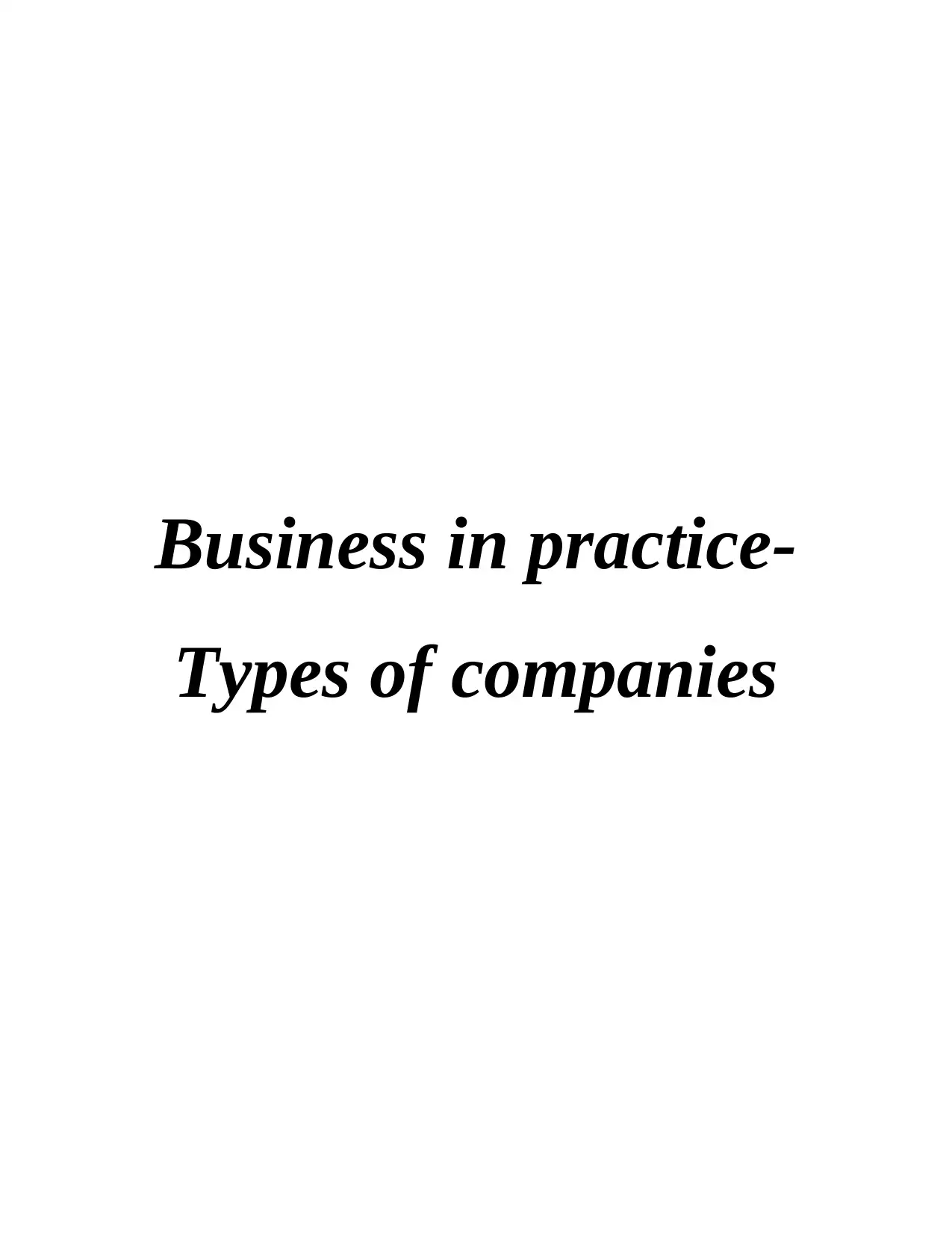
Business in practice-
Types of companies
Types of companies
Secure Best Marks with AI Grader
Need help grading? Try our AI Grader for instant feedback on your assignments.
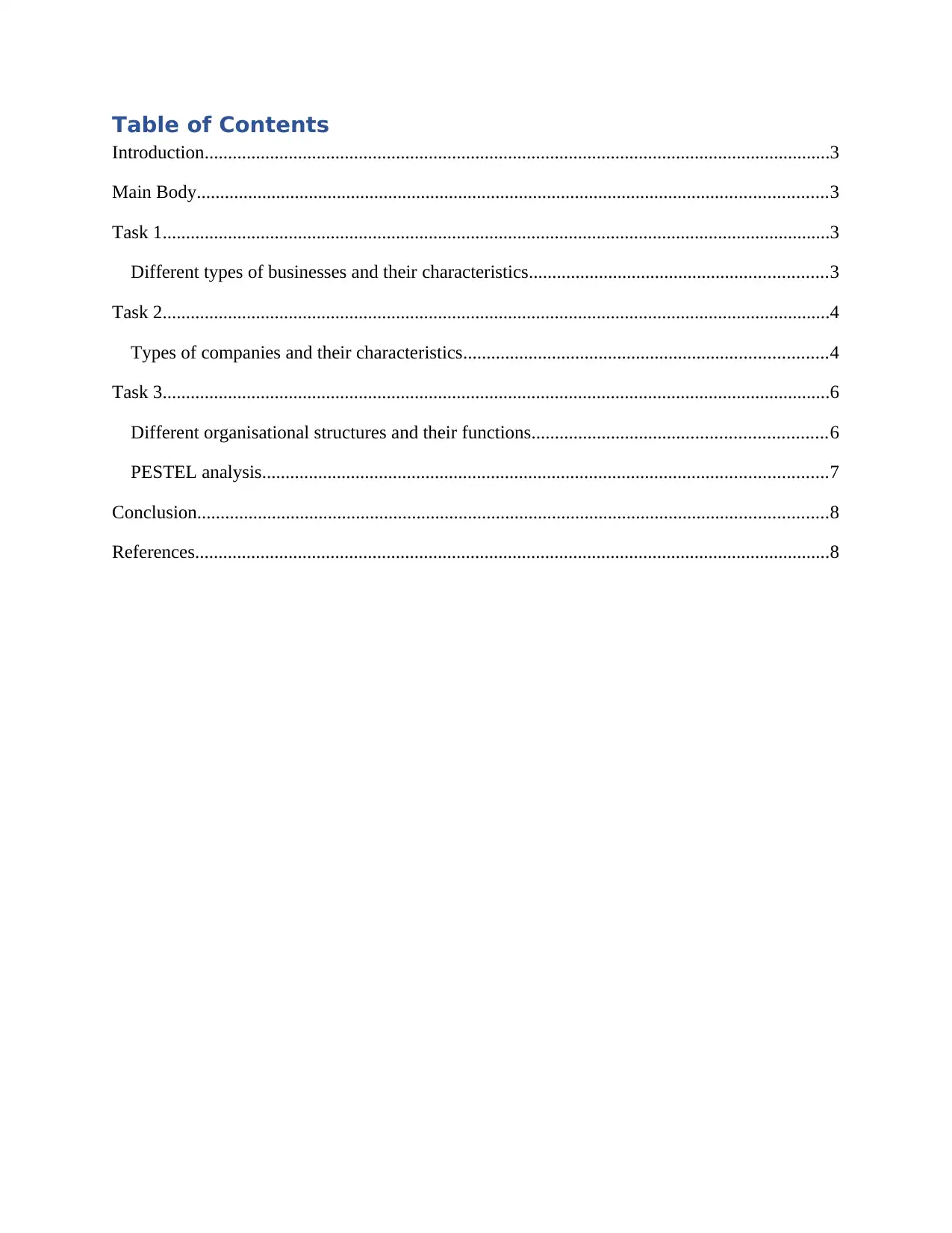
Table of Contents
Introduction......................................................................................................................................3
Main Body.......................................................................................................................................3
Task 1...............................................................................................................................................3
Different types of businesses and their characteristics................................................................3
Task 2...............................................................................................................................................4
Types of companies and their characteristics..............................................................................4
Task 3...............................................................................................................................................6
Different organisational structures and their functions...............................................................6
PESTEL analysis.........................................................................................................................7
Conclusion.......................................................................................................................................8
References........................................................................................................................................8
Introduction......................................................................................................................................3
Main Body.......................................................................................................................................3
Task 1...............................................................................................................................................3
Different types of businesses and their characteristics................................................................3
Task 2...............................................................................................................................................4
Types of companies and their characteristics..............................................................................4
Task 3...............................................................................................................................................6
Different organisational structures and their functions...............................................................6
PESTEL analysis.........................................................................................................................7
Conclusion.......................................................................................................................................8
References........................................................................................................................................8
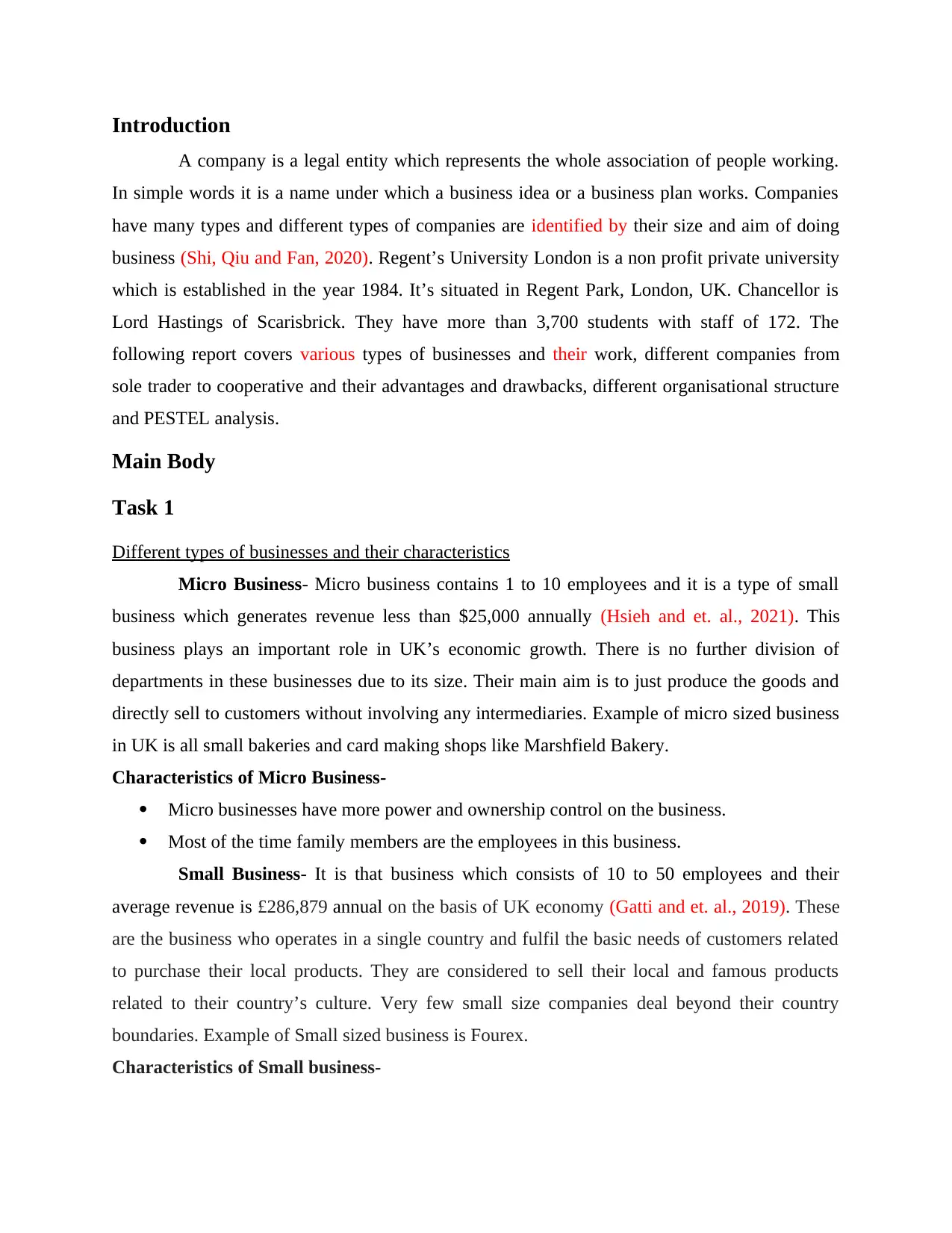
Introduction
A company is a legal entity which represents the whole association of people working.
In simple words it is a name under which a business idea or a business plan works. Companies
have many types and different types of companies are identified by their size and aim of doing
business (Shi, Qiu and Fan, 2020). Regent’s University London is a non profit private university
which is established in the year 1984. It’s situated in Regent Park, London, UK. Chancellor is
Lord Hastings of Scarisbrick. They have more than 3,700 students with staff of 172. The
following report covers various types of businesses and their work, different companies from
sole trader to cooperative and their advantages and drawbacks, different organisational structure
and PESTEL analysis.
Main Body
Task 1
Different types of businesses and their characteristics
Micro Business- Micro business contains 1 to 10 employees and it is a type of small
business which generates revenue less than $25,000 annually (Hsieh and et. al., 2021). This
business plays an important role in UK’s economic growth. There is no further division of
departments in these businesses due to its size. Their main aim is to just produce the goods and
directly sell to customers without involving any intermediaries. Example of micro sized business
in UK is all small bakeries and card making shops like Marshfield Bakery.
Characteristics of Micro Business-
Micro businesses have more power and ownership control on the business.
Most of the time family members are the employees in this business.
Small Business- It is that business which consists of 10 to 50 employees and their
average revenue is £286,879 annual on the basis of UK economy (Gatti and et. al., 2019). These
are the business who operates in a single country and fulfil the basic needs of customers related
to purchase their local products. They are considered to sell their local and famous products
related to their country’s culture. Very few small size companies deal beyond their country
boundaries. Example of Small sized business is Fourex.
Characteristics of Small business-
A company is a legal entity which represents the whole association of people working.
In simple words it is a name under which a business idea or a business plan works. Companies
have many types and different types of companies are identified by their size and aim of doing
business (Shi, Qiu and Fan, 2020). Regent’s University London is a non profit private university
which is established in the year 1984. It’s situated in Regent Park, London, UK. Chancellor is
Lord Hastings of Scarisbrick. They have more than 3,700 students with staff of 172. The
following report covers various types of businesses and their work, different companies from
sole trader to cooperative and their advantages and drawbacks, different organisational structure
and PESTEL analysis.
Main Body
Task 1
Different types of businesses and their characteristics
Micro Business- Micro business contains 1 to 10 employees and it is a type of small
business which generates revenue less than $25,000 annually (Hsieh and et. al., 2021). This
business plays an important role in UK’s economic growth. There is no further division of
departments in these businesses due to its size. Their main aim is to just produce the goods and
directly sell to customers without involving any intermediaries. Example of micro sized business
in UK is all small bakeries and card making shops like Marshfield Bakery.
Characteristics of Micro Business-
Micro businesses have more power and ownership control on the business.
Most of the time family members are the employees in this business.
Small Business- It is that business which consists of 10 to 50 employees and their
average revenue is £286,879 annual on the basis of UK economy (Gatti and et. al., 2019). These
are the business who operates in a single country and fulfil the basic needs of customers related
to purchase their local products. They are considered to sell their local and famous products
related to their country’s culture. Very few small size companies deal beyond their country
boundaries. Example of Small sized business is Fourex.
Characteristics of Small business-
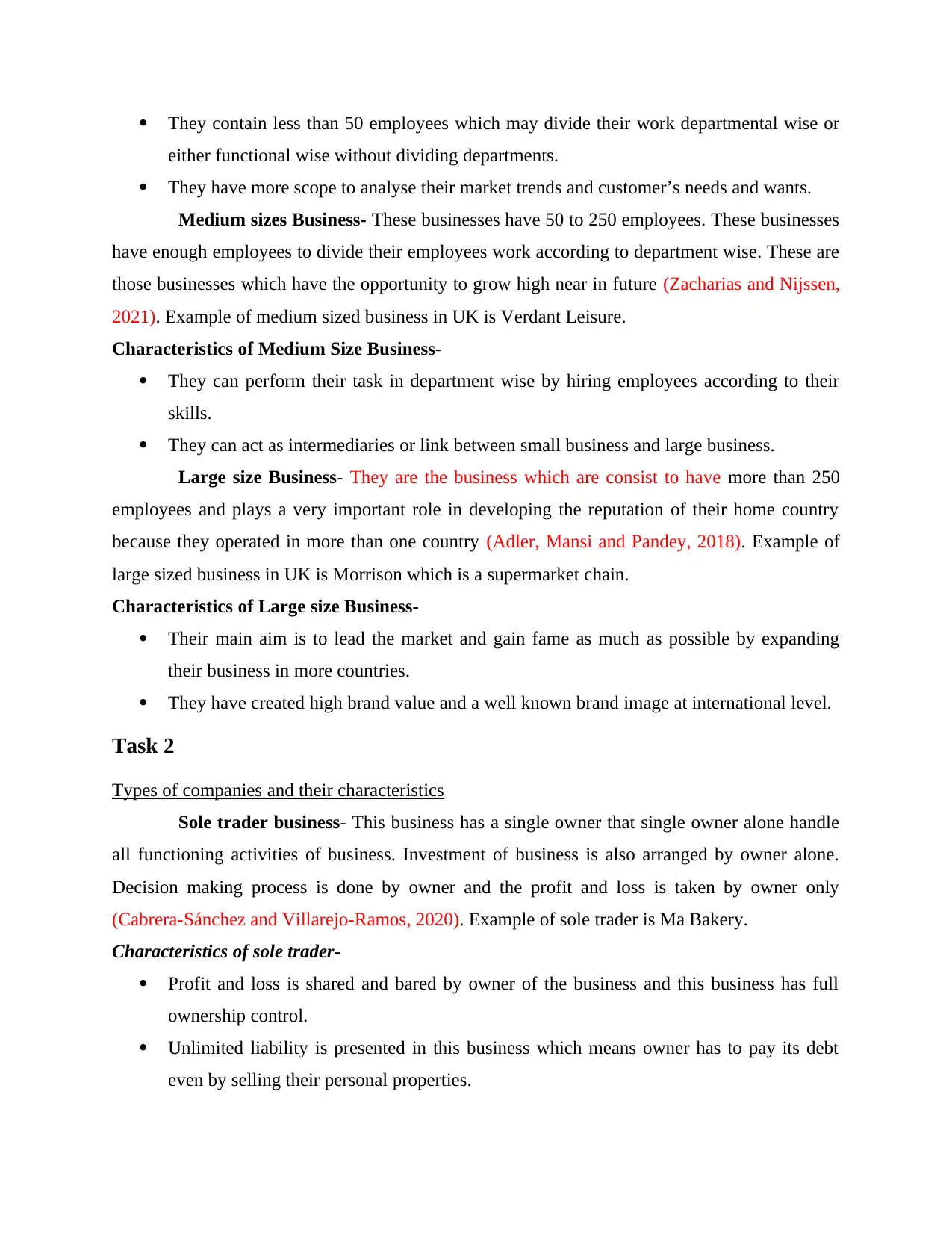
They contain less than 50 employees which may divide their work departmental wise or
either functional wise without dividing departments.
They have more scope to analyse their market trends and customer’s needs and wants.
Medium sizes Business- These businesses have 50 to 250 employees. These businesses
have enough employees to divide their employees work according to department wise. These are
those businesses which have the opportunity to grow high near in future (Zacharias and Nijssen,
2021). Example of medium sized business in UK is Verdant Leisure.
Characteristics of Medium Size Business-
They can perform their task in department wise by hiring employees according to their
skills.
They can act as intermediaries or link between small business and large business.
Large size Business- They are the business which are consist to have more than 250
employees and plays a very important role in developing the reputation of their home country
because they operated in more than one country (Adler, Mansi and Pandey, 2018). Example of
large sized business in UK is Morrison which is a supermarket chain.
Characteristics of Large size Business-
Their main aim is to lead the market and gain fame as much as possible by expanding
their business in more countries.
They have created high brand value and a well known brand image at international level.
Task 2
Types of companies and their characteristics
Sole trader business- This business has a single owner that single owner alone handle
all functioning activities of business. Investment of business is also arranged by owner alone.
Decision making process is done by owner and the profit and loss is taken by owner only
(Cabrera-Sánchez and Villarejo-Ramos, 2020). Example of sole trader is Ma Bakery.
Characteristics of sole trader-
Profit and loss is shared and bared by owner of the business and this business has full
ownership control.
Unlimited liability is presented in this business which means owner has to pay its debt
even by selling their personal properties.
either functional wise without dividing departments.
They have more scope to analyse their market trends and customer’s needs and wants.
Medium sizes Business- These businesses have 50 to 250 employees. These businesses
have enough employees to divide their employees work according to department wise. These are
those businesses which have the opportunity to grow high near in future (Zacharias and Nijssen,
2021). Example of medium sized business in UK is Verdant Leisure.
Characteristics of Medium Size Business-
They can perform their task in department wise by hiring employees according to their
skills.
They can act as intermediaries or link between small business and large business.
Large size Business- They are the business which are consist to have more than 250
employees and plays a very important role in developing the reputation of their home country
because they operated in more than one country (Adler, Mansi and Pandey, 2018). Example of
large sized business in UK is Morrison which is a supermarket chain.
Characteristics of Large size Business-
Their main aim is to lead the market and gain fame as much as possible by expanding
their business in more countries.
They have created high brand value and a well known brand image at international level.
Task 2
Types of companies and their characteristics
Sole trader business- This business has a single owner that single owner alone handle
all functioning activities of business. Investment of business is also arranged by owner alone.
Decision making process is done by owner and the profit and loss is taken by owner only
(Cabrera-Sánchez and Villarejo-Ramos, 2020). Example of sole trader is Ma Bakery.
Characteristics of sole trader-
Profit and loss is shared and bared by owner of the business and this business has full
ownership control.
Unlimited liability is presented in this business which means owner has to pay its debt
even by selling their personal properties.
Secure Best Marks with AI Grader
Need help grading? Try our AI Grader for instant feedback on your assignments.
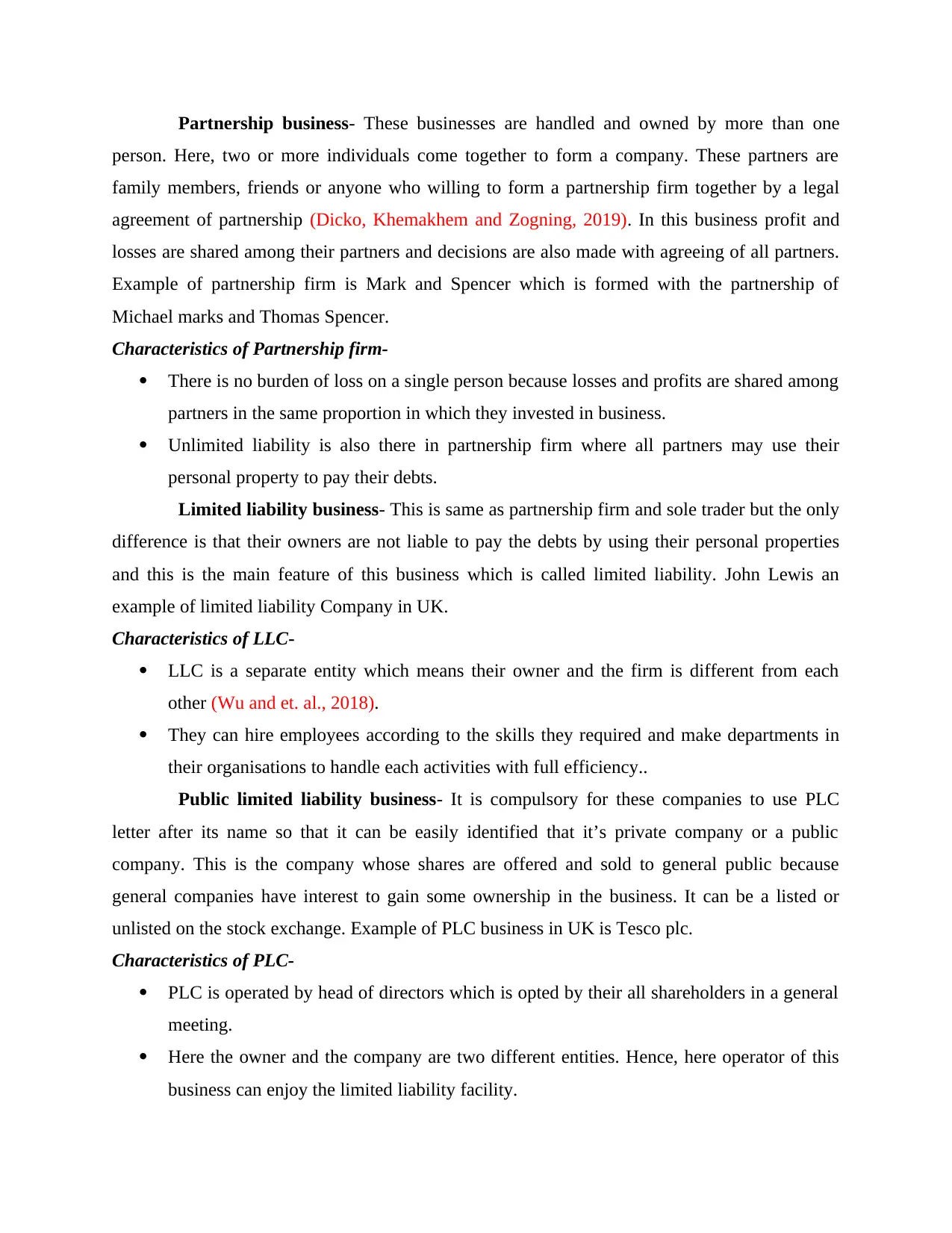
Partnership business- These businesses are handled and owned by more than one
person. Here, two or more individuals come together to form a company. These partners are
family members, friends or anyone who willing to form a partnership firm together by a legal
agreement of partnership (Dicko, Khemakhem and Zogning, 2019). In this business profit and
losses are shared among their partners and decisions are also made with agreeing of all partners.
Example of partnership firm is Mark and Spencer which is formed with the partnership of
Michael marks and Thomas Spencer.
Characteristics of Partnership firm-
There is no burden of loss on a single person because losses and profits are shared among
partners in the same proportion in which they invested in business.
Unlimited liability is also there in partnership firm where all partners may use their
personal property to pay their debts.
Limited liability business- This is same as partnership firm and sole trader but the only
difference is that their owners are not liable to pay the debts by using their personal properties
and this is the main feature of this business which is called limited liability. John Lewis an
example of limited liability Company in UK.
Characteristics of LLC-
LLC is a separate entity which means their owner and the firm is different from each
other (Wu and et. al., 2018).
They can hire employees according to the skills they required and make departments in
their organisations to handle each activities with full efficiency..
Public limited liability business- It is compulsory for these companies to use PLC
letter after its name so that it can be easily identified that it’s private company or a public
company. This is the company whose shares are offered and sold to general public because
general companies have interest to gain some ownership in the business. It can be a listed or
unlisted on the stock exchange. Example of PLC business in UK is Tesco plc.
Characteristics of PLC-
PLC is operated by head of directors which is opted by their all shareholders in a general
meeting.
Here the owner and the company are two different entities. Hence, here operator of this
business can enjoy the limited liability facility.
person. Here, two or more individuals come together to form a company. These partners are
family members, friends or anyone who willing to form a partnership firm together by a legal
agreement of partnership (Dicko, Khemakhem and Zogning, 2019). In this business profit and
losses are shared among their partners and decisions are also made with agreeing of all partners.
Example of partnership firm is Mark and Spencer which is formed with the partnership of
Michael marks and Thomas Spencer.
Characteristics of Partnership firm-
There is no burden of loss on a single person because losses and profits are shared among
partners in the same proportion in which they invested in business.
Unlimited liability is also there in partnership firm where all partners may use their
personal property to pay their debts.
Limited liability business- This is same as partnership firm and sole trader but the only
difference is that their owners are not liable to pay the debts by using their personal properties
and this is the main feature of this business which is called limited liability. John Lewis an
example of limited liability Company in UK.
Characteristics of LLC-
LLC is a separate entity which means their owner and the firm is different from each
other (Wu and et. al., 2018).
They can hire employees according to the skills they required and make departments in
their organisations to handle each activities with full efficiency..
Public limited liability business- It is compulsory for these companies to use PLC
letter after its name so that it can be easily identified that it’s private company or a public
company. This is the company whose shares are offered and sold to general public because
general companies have interest to gain some ownership in the business. It can be a listed or
unlisted on the stock exchange. Example of PLC business in UK is Tesco plc.
Characteristics of PLC-
PLC is operated by head of directors which is opted by their all shareholders in a general
meeting.
Here the owner and the company are two different entities. Hence, here operator of this
business can enjoy the limited liability facility.
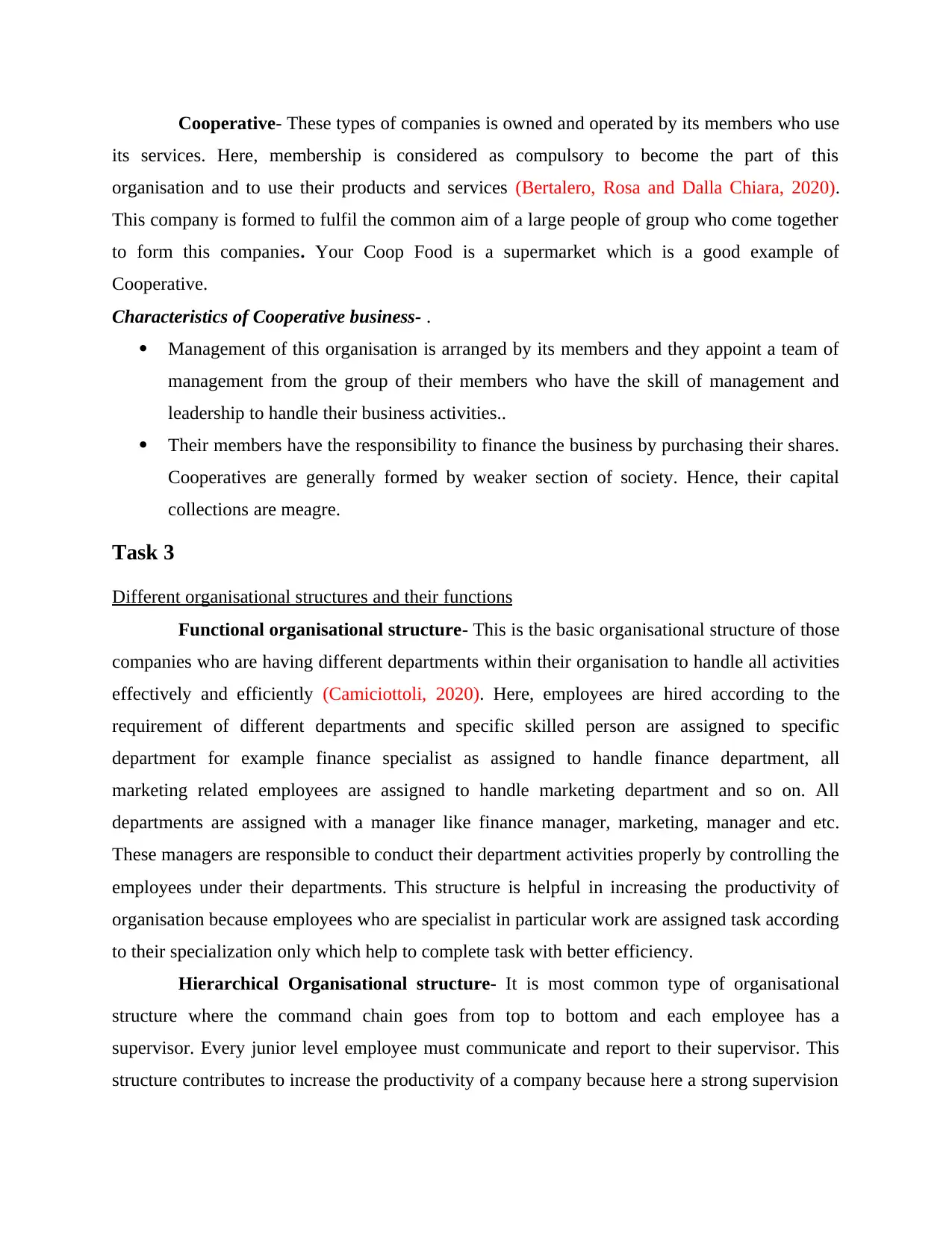
Cooperative- These types of companies is owned and operated by its members who use
its services. Here, membership is considered as compulsory to become the part of this
organisation and to use their products and services (Bertalero, Rosa and Dalla Chiara, 2020).
This company is formed to fulfil the common aim of a large people of group who come together
to form this companies. Your Coop Food is a supermarket which is a good example of
Cooperative.
Characteristics of Cooperative business- .
Management of this organisation is arranged by its members and they appoint a team of
management from the group of their members who have the skill of management and
leadership to handle their business activities..
Their members have the responsibility to finance the business by purchasing their shares.
Cooperatives are generally formed by weaker section of society. Hence, their capital
collections are meagre.
Task 3
Different organisational structures and their functions
Functional organisational structure- This is the basic organisational structure of those
companies who are having different departments within their organisation to handle all activities
effectively and efficiently (Camiciottoli, 2020). Here, employees are hired according to the
requirement of different departments and specific skilled person are assigned to specific
department for example finance specialist as assigned to handle finance department, all
marketing related employees are assigned to handle marketing department and so on. All
departments are assigned with a manager like finance manager, marketing, manager and etc.
These managers are responsible to conduct their department activities properly by controlling the
employees under their departments. This structure is helpful in increasing the productivity of
organisation because employees who are specialist in particular work are assigned task according
to their specialization only which help to complete task with better efficiency.
Hierarchical Organisational structure- It is most common type of organisational
structure where the command chain goes from top to bottom and each employee has a
supervisor. Every junior level employee must communicate and report to their supervisor. This
structure contributes to increase the productivity of a company because here a strong supervision
its services. Here, membership is considered as compulsory to become the part of this
organisation and to use their products and services (Bertalero, Rosa and Dalla Chiara, 2020).
This company is formed to fulfil the common aim of a large people of group who come together
to form this companies. Your Coop Food is a supermarket which is a good example of
Cooperative.
Characteristics of Cooperative business- .
Management of this organisation is arranged by its members and they appoint a team of
management from the group of their members who have the skill of management and
leadership to handle their business activities..
Their members have the responsibility to finance the business by purchasing their shares.
Cooperatives are generally formed by weaker section of society. Hence, their capital
collections are meagre.
Task 3
Different organisational structures and their functions
Functional organisational structure- This is the basic organisational structure of those
companies who are having different departments within their organisation to handle all activities
effectively and efficiently (Camiciottoli, 2020). Here, employees are hired according to the
requirement of different departments and specific skilled person are assigned to specific
department for example finance specialist as assigned to handle finance department, all
marketing related employees are assigned to handle marketing department and so on. All
departments are assigned with a manager like finance manager, marketing, manager and etc.
These managers are responsible to conduct their department activities properly by controlling the
employees under their departments. This structure is helpful in increasing the productivity of
organisation because employees who are specialist in particular work are assigned task according
to their specialization only which help to complete task with better efficiency.
Hierarchical Organisational structure- It is most common type of organisational
structure where the command chain goes from top to bottom and each employee has a
supervisor. Every junior level employee must communicate and report to their supervisor. This
structure contributes to increase the productivity of a company because here a strong supervision
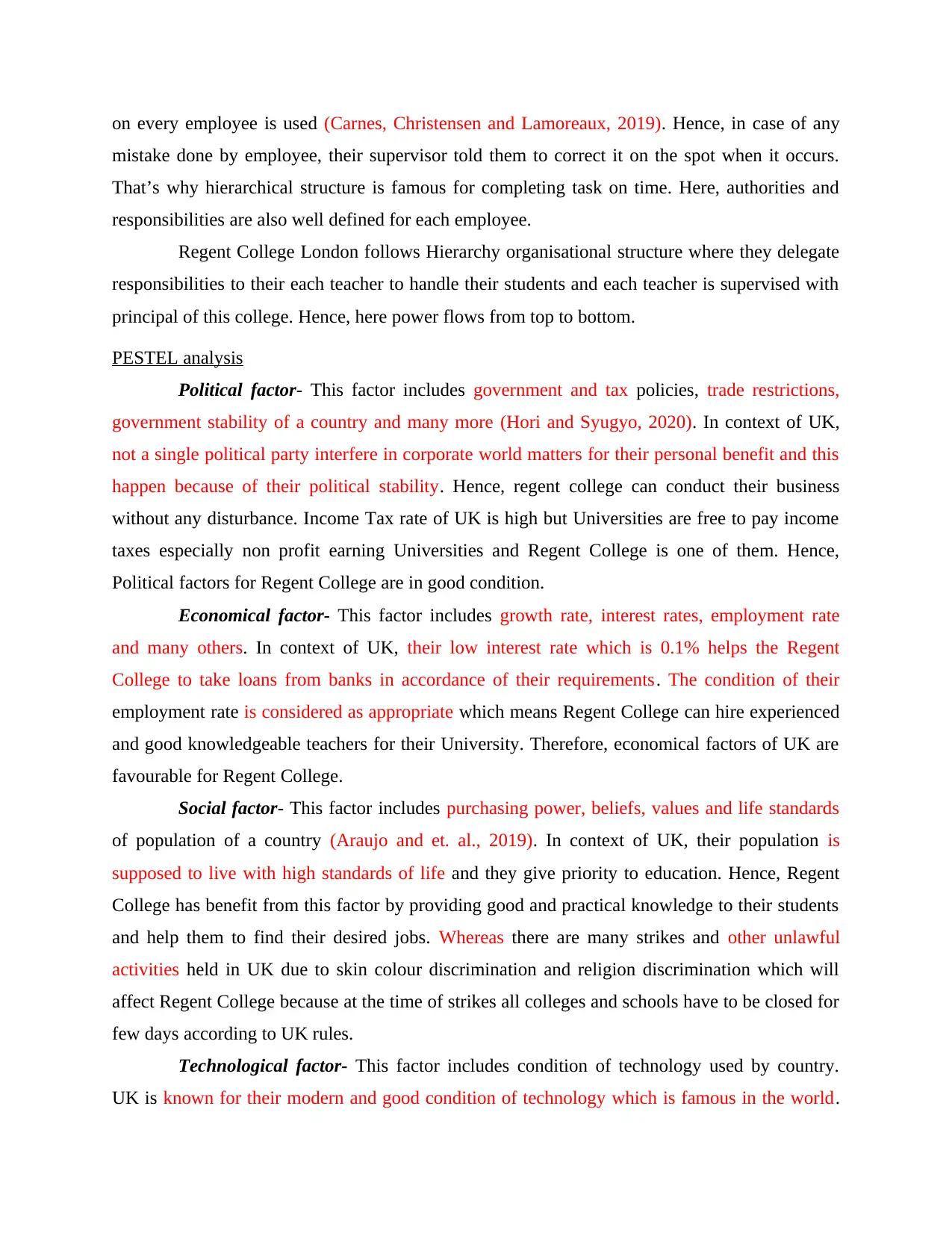
on every employee is used (Carnes, Christensen and Lamoreaux, 2019). Hence, in case of any
mistake done by employee, their supervisor told them to correct it on the spot when it occurs.
That’s why hierarchical structure is famous for completing task on time. Here, authorities and
responsibilities are also well defined for each employee.
Regent College London follows Hierarchy organisational structure where they delegate
responsibilities to their each teacher to handle their students and each teacher is supervised with
principal of this college. Hence, here power flows from top to bottom.
PESTEL analysis
Political factor- This factor includes government and tax policies, trade restrictions,
government stability of a country and many more (Hori and Syugyo, 2020). In context of UK,
not a single political party interfere in corporate world matters for their personal benefit and this
happen because of their political stability. Hence, regent college can conduct their business
without any disturbance. Income Tax rate of UK is high but Universities are free to pay income
taxes especially non profit earning Universities and Regent College is one of them. Hence,
Political factors for Regent College are in good condition.
Economical factor- This factor includes growth rate, interest rates, employment rate
and many others. In context of UK, their low interest rate which is 0.1% helps the Regent
College to take loans from banks in accordance of their requirements. The condition of their
employment rate is considered as appropriate which means Regent College can hire experienced
and good knowledgeable teachers for their University. Therefore, economical factors of UK are
favourable for Regent College.
Social factor- This factor includes purchasing power, beliefs, values and life standards
of population of a country (Araujo and et. al., 2019). In context of UK, their population is
supposed to live with high standards of life and they give priority to education. Hence, Regent
College has benefit from this factor by providing good and practical knowledge to their students
and help them to find their desired jobs. Whereas there are many strikes and other unlawful
activities held in UK due to skin colour discrimination and religion discrimination which will
affect Regent College because at the time of strikes all colleges and schools have to be closed for
few days according to UK rules.
Technological factor- This factor includes condition of technology used by country.
UK is known for their modern and good condition of technology which is famous in the world.
mistake done by employee, their supervisor told them to correct it on the spot when it occurs.
That’s why hierarchical structure is famous for completing task on time. Here, authorities and
responsibilities are also well defined for each employee.
Regent College London follows Hierarchy organisational structure where they delegate
responsibilities to their each teacher to handle their students and each teacher is supervised with
principal of this college. Hence, here power flows from top to bottom.
PESTEL analysis
Political factor- This factor includes government and tax policies, trade restrictions,
government stability of a country and many more (Hori and Syugyo, 2020). In context of UK,
not a single political party interfere in corporate world matters for their personal benefit and this
happen because of their political stability. Hence, regent college can conduct their business
without any disturbance. Income Tax rate of UK is high but Universities are free to pay income
taxes especially non profit earning Universities and Regent College is one of them. Hence,
Political factors for Regent College are in good condition.
Economical factor- This factor includes growth rate, interest rates, employment rate
and many others. In context of UK, their low interest rate which is 0.1% helps the Regent
College to take loans from banks in accordance of their requirements. The condition of their
employment rate is considered as appropriate which means Regent College can hire experienced
and good knowledgeable teachers for their University. Therefore, economical factors of UK are
favourable for Regent College.
Social factor- This factor includes purchasing power, beliefs, values and life standards
of population of a country (Araujo and et. al., 2019). In context of UK, their population is
supposed to live with high standards of life and they give priority to education. Hence, Regent
College has benefit from this factor by providing good and practical knowledge to their students
and help them to find their desired jobs. Whereas there are many strikes and other unlawful
activities held in UK due to skin colour discrimination and religion discrimination which will
affect Regent College because at the time of strikes all colleges and schools have to be closed for
few days according to UK rules.
Technological factor- This factor includes condition of technology used by country.
UK is known for their modern and good condition of technology which is famous in the world.
Paraphrase This Document
Need a fresh take? Get an instant paraphrase of this document with our AI Paraphraser
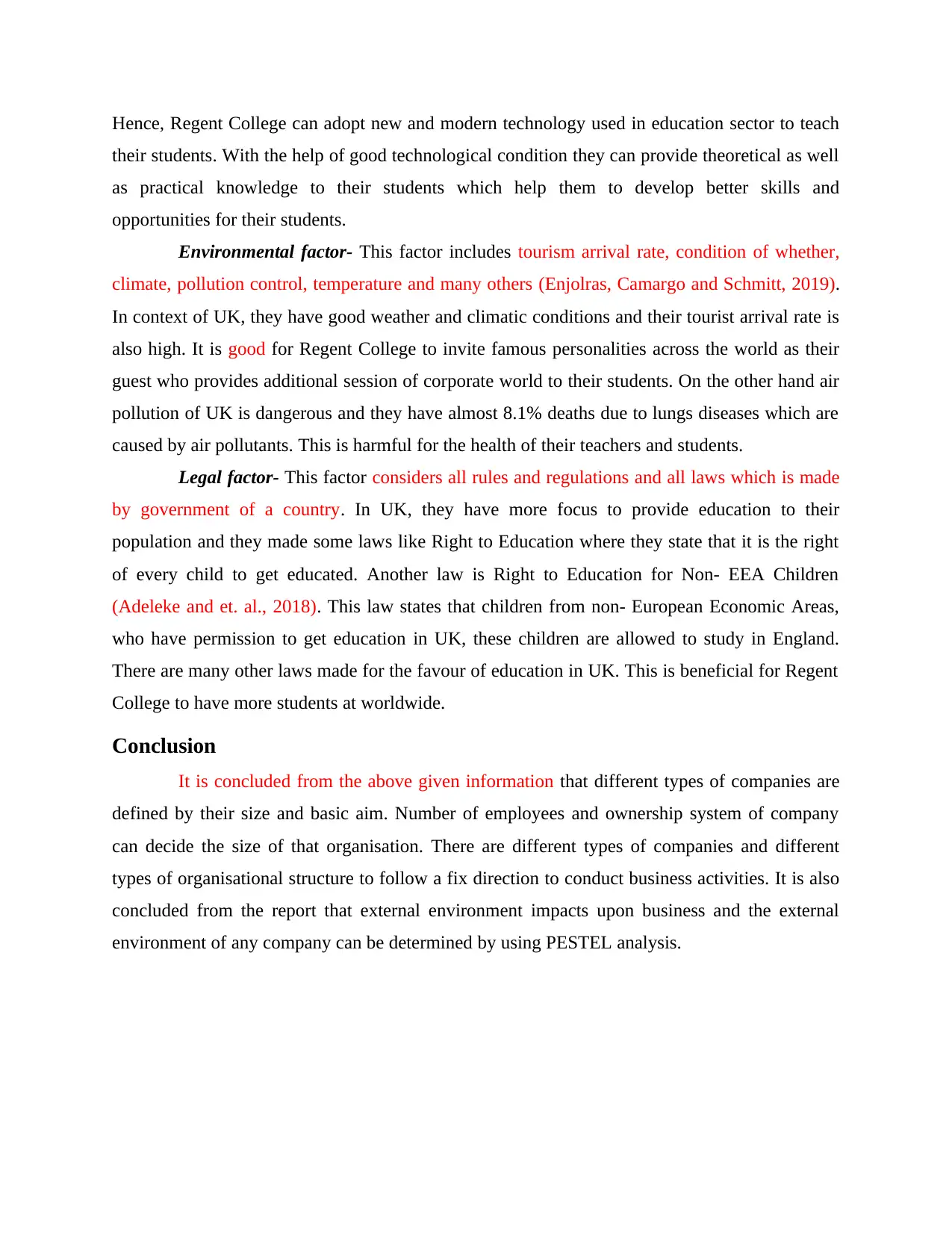
Hence, Regent College can adopt new and modern technology used in education sector to teach
their students. With the help of good technological condition they can provide theoretical as well
as practical knowledge to their students which help them to develop better skills and
opportunities for their students.
Environmental factor- This factor includes tourism arrival rate, condition of whether,
climate, pollution control, temperature and many others (Enjolras, Camargo and Schmitt, 2019).
In context of UK, they have good weather and climatic conditions and their tourist arrival rate is
also high. It is good for Regent College to invite famous personalities across the world as their
guest who provides additional session of corporate world to their students. On the other hand air
pollution of UK is dangerous and they have almost 8.1% deaths due to lungs diseases which are
caused by air pollutants. This is harmful for the health of their teachers and students.
Legal factor- This factor considers all rules and regulations and all laws which is made
by government of a country. In UK, they have more focus to provide education to their
population and they made some laws like Right to Education where they state that it is the right
of every child to get educated. Another law is Right to Education for Non- EEA Children
(Adeleke and et. al., 2018). This law states that children from non- European Economic Areas,
who have permission to get education in UK, these children are allowed to study in England.
There are many other laws made for the favour of education in UK. This is beneficial for Regent
College to have more students at worldwide.
Conclusion
It is concluded from the above given information that different types of companies are
defined by their size and basic aim. Number of employees and ownership system of company
can decide the size of that organisation. There are different types of companies and different
types of organisational structure to follow a fix direction to conduct business activities. It is also
concluded from the report that external environment impacts upon business and the external
environment of any company can be determined by using PESTEL analysis.
their students. With the help of good technological condition they can provide theoretical as well
as practical knowledge to their students which help them to develop better skills and
opportunities for their students.
Environmental factor- This factor includes tourism arrival rate, condition of whether,
climate, pollution control, temperature and many others (Enjolras, Camargo and Schmitt, 2019).
In context of UK, they have good weather and climatic conditions and their tourist arrival rate is
also high. It is good for Regent College to invite famous personalities across the world as their
guest who provides additional session of corporate world to their students. On the other hand air
pollution of UK is dangerous and they have almost 8.1% deaths due to lungs diseases which are
caused by air pollutants. This is harmful for the health of their teachers and students.
Legal factor- This factor considers all rules and regulations and all laws which is made
by government of a country. In UK, they have more focus to provide education to their
population and they made some laws like Right to Education where they state that it is the right
of every child to get educated. Another law is Right to Education for Non- EEA Children
(Adeleke and et. al., 2018). This law states that children from non- European Economic Areas,
who have permission to get education in UK, these children are allowed to study in England.
There are many other laws made for the favour of education in UK. This is beneficial for Regent
College to have more students at worldwide.
Conclusion
It is concluded from the above given information that different types of companies are
defined by their size and basic aim. Number of employees and ownership system of company
can decide the size of that organisation. There are different types of companies and different
types of organisational structure to follow a fix direction to conduct business activities. It is also
concluded from the report that external environment impacts upon business and the external
environment of any company can be determined by using PESTEL analysis.
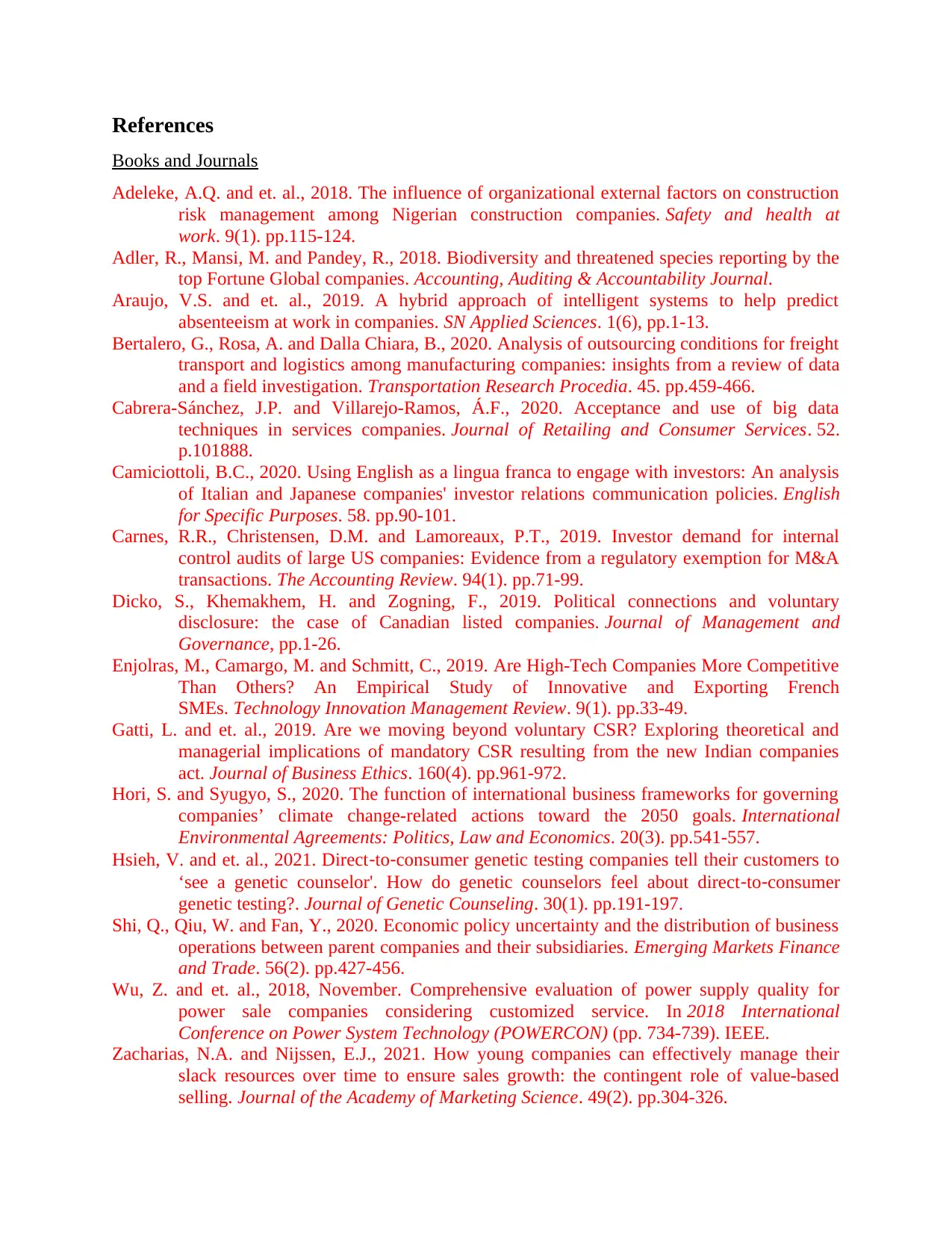
References
Books and Journals
Adeleke, A.Q. and et. al., 2018. The influence of organizational external factors on construction
risk management among Nigerian construction companies. Safety and health at
work. 9(1). pp.115-124.
Adler, R., Mansi, M. and Pandey, R., 2018. Biodiversity and threatened species reporting by the
top Fortune Global companies. Accounting, Auditing & Accountability Journal.
Araujo, V.S. and et. al., 2019. A hybrid approach of intelligent systems to help predict
absenteeism at work in companies. SN Applied Sciences. 1(6), pp.1-13.
Bertalero, G., Rosa, A. and Dalla Chiara, B., 2020. Analysis of outsourcing conditions for freight
transport and logistics among manufacturing companies: insights from a review of data
and a field investigation. Transportation Research Procedia. 45. pp.459-466.
Cabrera-Sánchez, J.P. and Villarejo-Ramos, Á.F., 2020. Acceptance and use of big data
techniques in services companies. Journal of Retailing and Consumer Services. 52.
p.101888.
Camiciottoli, B.C., 2020. Using English as a lingua franca to engage with investors: An analysis
of Italian and Japanese companies' investor relations communication policies. English
for Specific Purposes. 58. pp.90-101.
Carnes, R.R., Christensen, D.M. and Lamoreaux, P.T., 2019. Investor demand for internal
control audits of large US companies: Evidence from a regulatory exemption for M&A
transactions. The Accounting Review. 94(1). pp.71-99.
Dicko, S., Khemakhem, H. and Zogning, F., 2019. Political connections and voluntary
disclosure: the case of Canadian listed companies. Journal of Management and
Governance, pp.1-26.
Enjolras, M., Camargo, M. and Schmitt, C., 2019. Are High-Tech Companies More Competitive
Than Others? An Empirical Study of Innovative and Exporting French
SMEs. Technology Innovation Management Review. 9(1). pp.33-49.
Gatti, L. and et. al., 2019. Are we moving beyond voluntary CSR? Exploring theoretical and
managerial implications of mandatory CSR resulting from the new Indian companies
act. Journal of Business Ethics. 160(4). pp.961-972.
Hori, S. and Syugyo, S., 2020. The function of international business frameworks for governing
companies’ climate change-related actions toward the 2050 goals. International
Environmental Agreements: Politics, Law and Economics. 20(3). pp.541-557.
Hsieh, V. and et. al., 2021. Direct‐to‐consumer genetic testing companies tell their customers to
‘see a genetic counselor'. How do genetic counselors feel about direct‐to‐consumer
genetic testing?. Journal of Genetic Counseling. 30(1). pp.191-197.
Shi, Q., Qiu, W. and Fan, Y., 2020. Economic policy uncertainty and the distribution of business
operations between parent companies and their subsidiaries. Emerging Markets Finance
and Trade. 56(2). pp.427-456.
Wu, Z. and et. al., 2018, November. Comprehensive evaluation of power supply quality for
power sale companies considering customized service. In 2018 International
Conference on Power System Technology (POWERCON) (pp. 734-739). IEEE.
Zacharias, N.A. and Nijssen, E.J., 2021. How young companies can effectively manage their
slack resources over time to ensure sales growth: the contingent role of value-based
selling. Journal of the Academy of Marketing Science. 49(2). pp.304-326.
Books and Journals
Adeleke, A.Q. and et. al., 2018. The influence of organizational external factors on construction
risk management among Nigerian construction companies. Safety and health at
work. 9(1). pp.115-124.
Adler, R., Mansi, M. and Pandey, R., 2018. Biodiversity and threatened species reporting by the
top Fortune Global companies. Accounting, Auditing & Accountability Journal.
Araujo, V.S. and et. al., 2019. A hybrid approach of intelligent systems to help predict
absenteeism at work in companies. SN Applied Sciences. 1(6), pp.1-13.
Bertalero, G., Rosa, A. and Dalla Chiara, B., 2020. Analysis of outsourcing conditions for freight
transport and logistics among manufacturing companies: insights from a review of data
and a field investigation. Transportation Research Procedia. 45. pp.459-466.
Cabrera-Sánchez, J.P. and Villarejo-Ramos, Á.F., 2020. Acceptance and use of big data
techniques in services companies. Journal of Retailing and Consumer Services. 52.
p.101888.
Camiciottoli, B.C., 2020. Using English as a lingua franca to engage with investors: An analysis
of Italian and Japanese companies' investor relations communication policies. English
for Specific Purposes. 58. pp.90-101.
Carnes, R.R., Christensen, D.M. and Lamoreaux, P.T., 2019. Investor demand for internal
control audits of large US companies: Evidence from a regulatory exemption for M&A
transactions. The Accounting Review. 94(1). pp.71-99.
Dicko, S., Khemakhem, H. and Zogning, F., 2019. Political connections and voluntary
disclosure: the case of Canadian listed companies. Journal of Management and
Governance, pp.1-26.
Enjolras, M., Camargo, M. and Schmitt, C., 2019. Are High-Tech Companies More Competitive
Than Others? An Empirical Study of Innovative and Exporting French
SMEs. Technology Innovation Management Review. 9(1). pp.33-49.
Gatti, L. and et. al., 2019. Are we moving beyond voluntary CSR? Exploring theoretical and
managerial implications of mandatory CSR resulting from the new Indian companies
act. Journal of Business Ethics. 160(4). pp.961-972.
Hori, S. and Syugyo, S., 2020. The function of international business frameworks for governing
companies’ climate change-related actions toward the 2050 goals. International
Environmental Agreements: Politics, Law and Economics. 20(3). pp.541-557.
Hsieh, V. and et. al., 2021. Direct‐to‐consumer genetic testing companies tell their customers to
‘see a genetic counselor'. How do genetic counselors feel about direct‐to‐consumer
genetic testing?. Journal of Genetic Counseling. 30(1). pp.191-197.
Shi, Q., Qiu, W. and Fan, Y., 2020. Economic policy uncertainty and the distribution of business
operations between parent companies and their subsidiaries. Emerging Markets Finance
and Trade. 56(2). pp.427-456.
Wu, Z. and et. al., 2018, November. Comprehensive evaluation of power supply quality for
power sale companies considering customized service. In 2018 International
Conference on Power System Technology (POWERCON) (pp. 734-739). IEEE.
Zacharias, N.A. and Nijssen, E.J., 2021. How young companies can effectively manage their
slack resources over time to ensure sales growth: the contingent role of value-based
selling. Journal of the Academy of Marketing Science. 49(2). pp.304-326.
1 out of 9
Related Documents
Your All-in-One AI-Powered Toolkit for Academic Success.
+13062052269
info@desklib.com
Available 24*7 on WhatsApp / Email
![[object Object]](/_next/static/media/star-bottom.7253800d.svg)
Unlock your academic potential
© 2024 | Zucol Services PVT LTD | All rights reserved.





